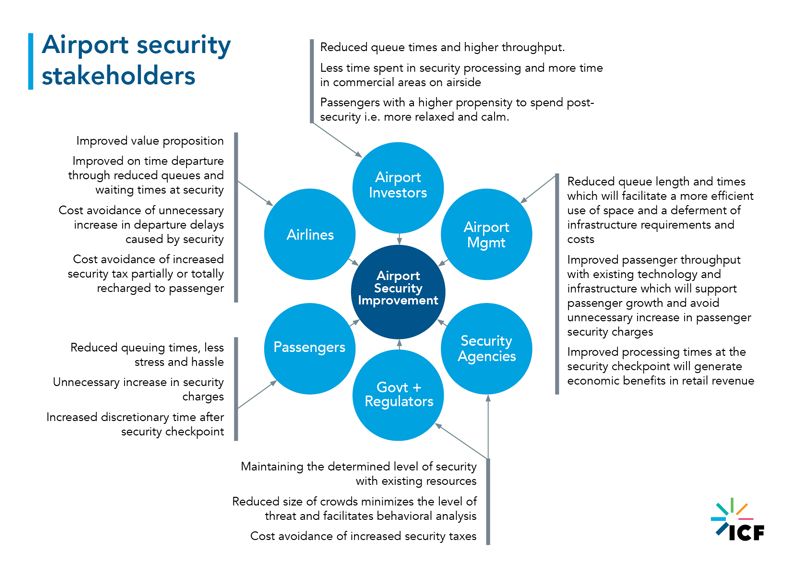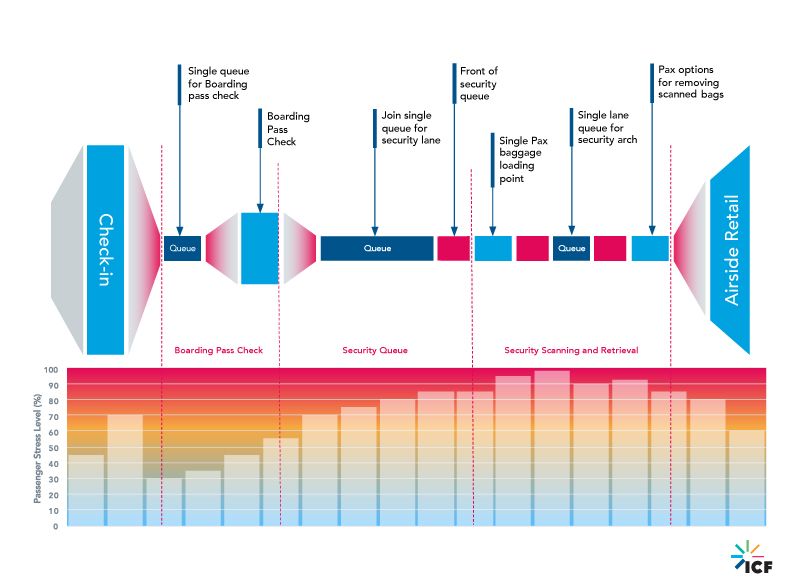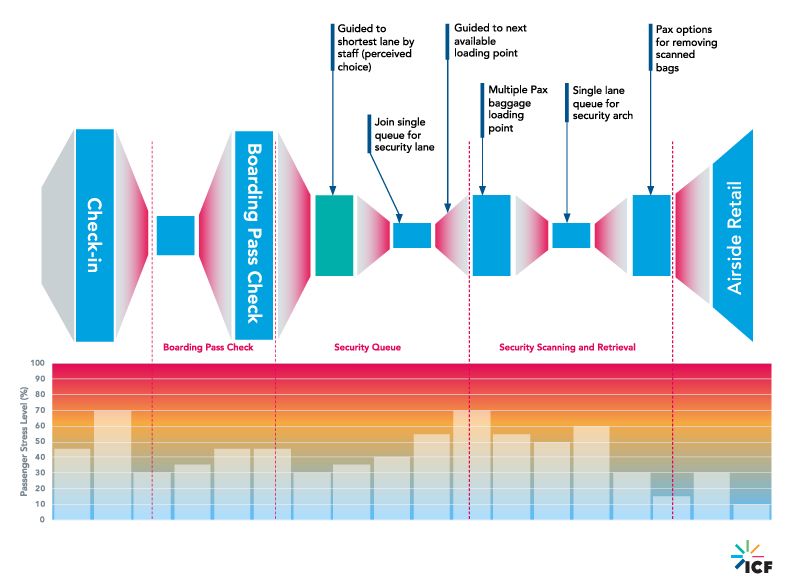No shoes. No liquids. No control: Making airport security less stressful for passengers
Security screening is the most difficult aspect of managing the customer experience at airports—especially for the passengers themselves. It’s not that the process is extensive; passengers often attribute feeling safe and secure to the rigorousness of security screenings. The challenge has more to do with a feeling of uncertainty and helplessness, of not being in control, which leads to high stress levels and agitation.
Part of the challenge is mitigating this stress. A process that keeps the passenger in a state of high anxiety without periods of relief requires significant recovery time. From the airport investor’s perspective, this is the opposite of how you want your customers to feel when they enter your newly-refurbished, state-of-the-art shopping experience.

But it's not all bad. We’ve seen significant differences between the best and worst-performing security processes. And the disparity is not merely a reflection of different government agencies with different policies—it is a reflection of the airport's design.
In the UK, for example, there are vast differences between airport terminals—even among those of similar size. They provide completely distinct customer experiences, especially in terms of passenger stress management. A key factor is the speed of processing, which, unfortunately, is often (but not always) a result of infrastructure restrictions. The limited space afforded to security in older terminals can restrict technology choices, especially if management is looking to maximize retail space.
Several surveys from International Air Transport Association, Airports Council International, SITA, DKMA, and other interested parties have looked at metrics related to airport customer experience spending. Examples of airport passenger spending habits include:
- Happy, relaxed travelers spend 7% more money on average on retail and 10% more on duty-free items.
- One hour more at an airport is around $7 more spent per passenger.
- For every 10 minutes a passenger spends in the security line, they spend 30% less money on retail items.
One key aspect appears to be the release of pressure that creates passenger stress.
Imagine a security processing entrance with crowds of people in multiple queues. Which queue do you join? Which will be the fastest? The lines lead into a noisy, constrained environment. You cannot change into a quicker queue. There is no staff to guide you. The atmosphere is oppressive. And the person five ahead of you in the line did not attempt to prepare for reaching the front. He is now slowly going through his bag looking for liquids and taking off his coat, his belt, and his shoes even though no one asked him to. Frustrating, right?
Stress levels gradually rise as we get stuck within a process we cannot control and, in some cases, of which we have limited awareness:

This stress keeps growing throughout the experience. There is no release to bring it down—it continues building. Even though the passenger gets a break in the end, it does not make up for the slow processing and uncertainty.
Now, let’s imagine an alternative. You approach a single queue, and the openness of the area allows you to see how the process works and where the security scanners are located in relation to people queueing. You are mentally prepared for the experience. The security area is designed to be quiet and efficient, with good lighting and clear sightlines. You are directed to the shortest line at the front of the main queue, and there are multiple loading areas for the scanners. The person next to you—who has decided to empty his bag—can take his time, as it does not affect you. Multiple repacking areas allow easy access to the other side of the scanning conveyor.

In this scenario, the passenger retains a degree of control. Though limited by a mandatory process, the airport has worked to optimize each individual’s experience of security screenings. The passenger arrives at the commercial side of the airport with much lower levels of stress. Each anxiety-building situation is followed by a stress-reducing aspect, giving the passenger clarity on their progress and the appearance of choice and control.
So let’s summarize the best practices:
- Open entry to security: This allows passengers to assess the situation and eases their concerns of delay. They can consider how to prepare themselves for the screening.
Compare, for example, the new security zones at Gatwick—with open sightlines from boarding pass check to Terminal 3—to Heathrow, which struggles with an old layout built in a different time. Heathrow's security remains hidden behind full-height screens, so the passenger has no idea what to expect when they turn the corner.
The unknown creates tension. The fear of choosing the “wrong” line makes the queue wait feel longer than it is. Airports need to give the passenger the ability to make an informed decision.
- Take passengers out of the queue: This allows them to operate at their own pace (fast people can overtake the slower-moving individuals). Passengers who travel lightly don’t get held back by those who travel heavily.
- A preparation zone before the roller bed: A preparation zone allows passengers to unload as needed instead of waiting for the person in front of them.
- Multiple entry and make-up points to the roller bed: These options allow passengers to load the roller bed as each tray becomes ready. A remote preparation zone can force passengers to waste time ferrying trays.
- Take observers of the x-ray screen off the shop floor: Moving these agents away from the hustle and bustle of the security area into a separate room permits focus on human factors. Observers have a far better environment (including lighting, ergonomics, and staffing patterns) in which to process images. It allows multiple viewers of each x-ray, allocating the next image to the next available observer. This avoids holding up the queue for just one image.
- After the x-ray, screen off the roller bed to discourage passengers from waiting at the exit for their bags: This change will encourage them to move further along, creating space for the next passenger.
- Multiple re-bagging areas after the x-ray: By repeating the pattern from the start of the process, passengers can operate at their own speeds without influencing others.
- Create space to recoup and get the family back together: A recovery space puts passengers in a better frame of mind before moving onto the next stage of their journey, which is usually the duty-free area. You want passengers in a happy mindset to make purchases.
- Automatic tray return: Rather than putting passengers to work bussing their trays or forcing agents to gather them up, an automatic return mechanism makes everyone’s lives easier.
Of course, not all of this is possible within the confines of legacy infrastructure. But, adopting as many of these principles as space and capital permits will pay returns to passenger well-being and the airport’s bottom line. Empowering the passenger during the security process—even if only to elicit appreciation for the less-stressful environment—improves both the customer’s state of mind and the airport’s performance.